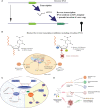FNC: An Advanced Anticancer Therapeutic or Just an Underdog?
- PMID: 35223502
- PMCID: PMC8867032
- DOI: 10.3389/fonc.2022.820647
FNC: An Advanced Anticancer Therapeutic or Just an Underdog?
Abstract
Azvudine (FNC) is a novel cytidine analogue that has both antiviral and anticancer activities. This minireview focuses on its underlying molecular mechanisms of suppressing viral life cycle and cancer cell growth and discusses applications of this nucleoside drug for advanced therapy of tumors and malignant blood diseases. FNC inhibits positive-stand RNA viruses, like HCV, EV, SARS-COV-2, HBV, and retroviruses, including HIV, by suppressing their RNA-dependent polymerase enzymes. It may also inhibit such enzyme (reverse transcriptase) in the human retrotransposons, including human endogenous retroviruses (HERVs). As the activation of retrotransposons can be the major factor of ongoing cancer genome instability and consequently higher aggressiveness of tumors, FNC has a potential to increase the efficacy of multiple anticancer therapies. Furthermore, FNC also showed other aspects of anticancer activity by inhibiting adhesion, migration, invasion, and proliferation of malignant cells. It was also reported to be involved in cell cycle arrest and apoptosis, thereby inhibiting the progression of cancer through different pathways. To the date, the grounds of FNC effects on cancer cells are not fully understood and hence additional studies are needed for better understanding molecular mechanisms of its anticancer activities to support its medical use in oncology.
Keywords: FNC; azvudine; cancer; nucleoside (acid) analogues; oncology.
Copyright © 2022 Fayzullina, Kharwar, Acharya, Buzdin, Borisov, Timashev, Ulasov and Kapomba.
Conflict of interest statement
Author AB is employed by OmicsWay Corp., Walnut, CA, 91789, USA. The remaining authors declare that the research was conducted in the absence of any commercial or financial relationships that could be construed as a potential conflict of interest.
Figures


Similar articles
-
4'-Modified Nucleosides for Antiviral Drug Discovery: Achievements and Perspectives.Acc Chem Res. 2022 Feb 15;55(4):565-578. doi: 10.1021/acs.accounts.1c00697. Epub 2022 Jan 25. Acc Chem Res. 2022. PMID: 35077644
-
FNC, a novel nucleoside analogue inhibits cell proliferation and tumor growth in a variety of human cancer cells.Biochem Pharmacol. 2011 Apr 1;81(7):848-55. doi: 10.1016/j.bcp.2011.01.001. Epub 2011 Jan 8. Biochem Pharmacol. 2011. PMID: 21219886
-
Azvudine is a thymus-homing anti-SARS-CoV-2 drug effective in treating COVID-19 patients.Signal Transduct Target Ther. 2021 Dec 6;6(1):414. doi: 10.1038/s41392-021-00835-6. Signal Transduct Target Ther. 2021. PMID: 34873151 Free PMC article.
-
Putative Repurposing of Lamivudine, a Nucleoside/Nucleotide Analogue and Antiretroviral to Improve the Outcome of Cancer and COVID-19 Patients.Front Oncol. 2021 Jul 21;11:664794. doi: 10.3389/fonc.2021.664794. eCollection 2021. Front Oncol. 2021. PMID: 34367956 Free PMC article. Review.
-
Hepatitis B virus reverse transcriptase - Target of current antiviral therapy and future drug development.Antiviral Res. 2015 Nov;123:132-7. doi: 10.1016/j.antiviral.2015.09.011. Epub 2015 Sep 25. Antiviral Res. 2015. PMID: 26408354 Free PMC article. Review.
Cited by
-
Advanced prodrug strategies in nucleoside analogues targeting the treatment of gastrointestinal malignancies.Front Cell Dev Biol. 2023 Apr 18;11:1173432. doi: 10.3389/fcell.2023.1173432. eCollection 2023. Front Cell Dev Biol. 2023. PMID: 37143892 Free PMC article. Review.
-
A Comparison of Etiology, Pathogenesis, Vaccinal and Antiviral Drug Development between Influenza and COVID-19.Int J Mol Sci. 2023 Mar 28;24(7):6369. doi: 10.3390/ijms24076369. Int J Mol Sci. 2023. PMID: 37047339 Free PMC article. Review.
-
Small molecules in the treatment of COVID-19.Signal Transduct Target Ther. 2022 Dec 5;7(1):387. doi: 10.1038/s41392-022-01249-8. Signal Transduct Target Ther. 2022. PMID: 36464706 Free PMC article. Review.
-
Mitochondrial-mediated apoptosis as a therapeutic target for FNC (2'-deoxy-2'-b-fluoro-4'-azidocytidine)-induced inhibition of Dalton's lymphoma growth and proliferation.Discov Oncol. 2024 Jan 22;15(1):16. doi: 10.1007/s12672-023-00829-6. Discov Oncol. 2024. PMID: 38252337 Free PMC article.
-
Safety Assessment of a Nucleoside Analogue FNC (2'-deoxy-2'- β-fluoro-4'-azidocytidine ) in Balb/c Mice: Acute Toxicity Study.Asian Pac J Cancer Prev. 2023 Jun 1;24(6):2157-2170. doi: 10.31557/APJCP.2023.24.6.2157. Asian Pac J Cancer Prev. 2023. PMID: 37378948 Free PMC article.
References
-
- Yang Q, Zhao X, Zang L, Fang X, Zhao J, Yang X, et al. . Anti-Hepatitis B Virus Activities of α-DDB–FNC, a Novel Nucleoside–Biphenyldicarboxylate Compound in Cells and Ducks, and its Anti-Immunological Liver Injury Effect in Mice. Antiviral Res (2012) 96: (3):333–9. doi: 10.1016/j.antiviral.2012.10.003 - DOI - PubMed
Publication types
LinkOut - more resources
Full Text Sources
Other Literature Sources
Research Materials
Miscellaneous

